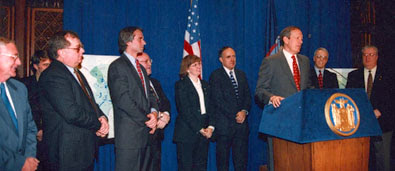1997 New York City Watershed Memorandum of Agreement
The city passed its watershed regulations in 1997 with the New York City Watershed Memorandum of Agreement. With it came a five year Filtration Avoidance Determination, which allowed the city time to prove that a filtration plant was unnecessary, and the ability to purchase 355,000 acres of land from willing sellers for full market value in the watershed. Upstate communities won the prohibition of property condemnation and received financial compensation for the extra costs of adhering to the new regulations. Some of the regulations included prohibiting septic tanks, fuel tanks, and impervious surfaces within 100 feet of water. Upstate communities were also allocated funds for environmentally minded economic development, which was to be run and developed by the new Catskill Watershed Corporation.
Between 1997 and 2011, nearly 1,400 landowners signed purchase contracts to sell 120,000 acres of land or easements at fair market value in the Catskill/Delaware and Croton watershed systems. The Land Acquisition Program, started in 1997, focused mostly on forested land in the Catskill and Delaware watersheds. Prior to the start of the Land Acquisition Program, the city had purchased 44,600 acres surrounding the reservoirs. New York State also owns and protects more than 200,000 acres of watershed lands.

Diane Galusha on the MOA
Chloe Kellner: Can you describe some of the frustrations that Catskills residents had with the Memorandum of Agreement, and what you think helped representatives from both NYC and upstate come to an agreement?
Diane Galusha: The history was the biggest issue. The city had basically come to the Catskills, and before that to Westchester and Putnam counties, and basically claimed (by eminent domain) the territory to build reservoirs for the millions of people who live a long way away. People had already given up a lot. Under eminent domain you must leave, and then you argue for what you believe the property is worth. That was another sore point because a lot of people felt they hadn’t gotten the money that their property and communities deserved.
— From our interview with Diane Galusha, The Fight for Water Access: Liquid Assets and New York City’s Watershed. Read the full interview here.


